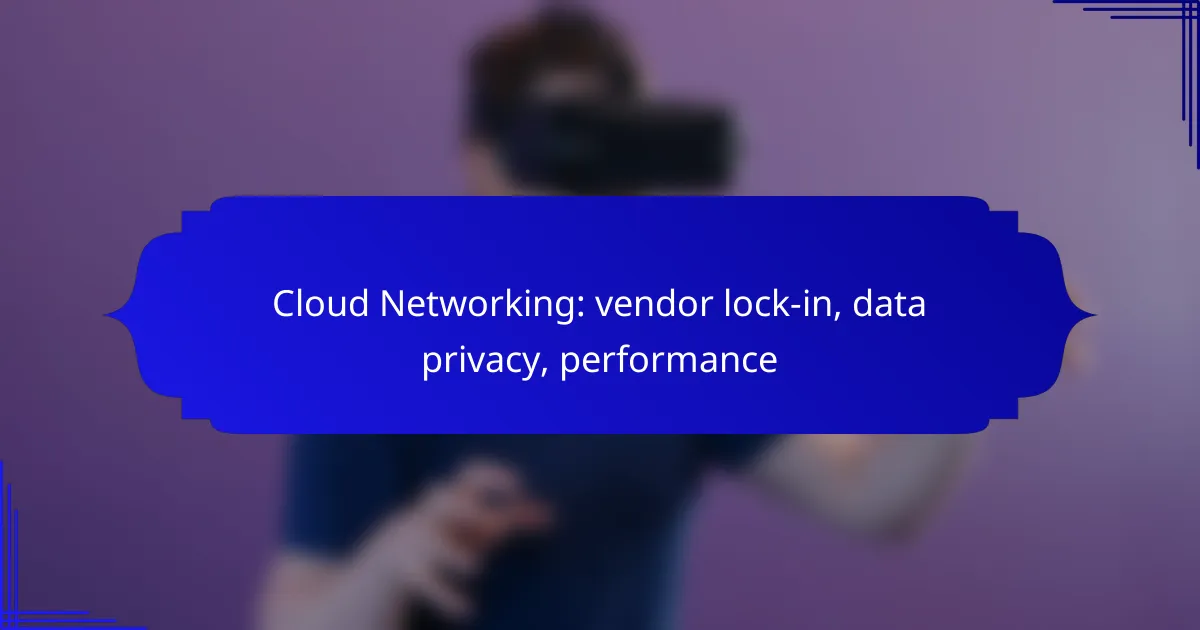Cloud networking presents both opportunities and challenges for organizations, particularly concerning vendor lock-in, data privacy, and performance. To mitigate the risk of vendor lock-in, businesses can implement multi-cloud strategies and prioritize data portability. Additionally, safeguarding sensitive information in the cloud requires adherence to regulations and robust encryption practices. Finally, understanding the impact of cloud networking on latency and bandwidth is crucial for optimizing performance and enhancing user experience.
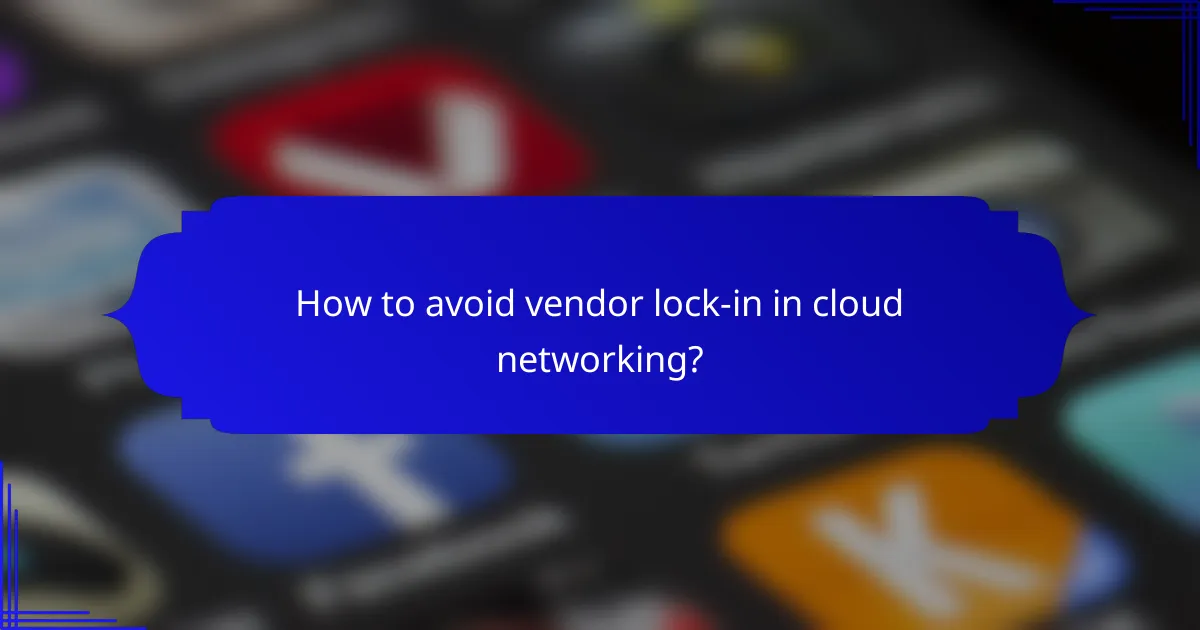
How to avoid vendor lock-in in cloud networking?
To avoid vendor lock-in in cloud networking, organizations should adopt strategies that promote flexibility and interoperability among different cloud services. This can be achieved through multi-cloud strategies, open-source solutions, effective contract negotiation, and ensuring data portability.
Multi-cloud strategies
Implementing a multi-cloud strategy involves using services from multiple cloud providers to distribute workloads. This approach reduces dependency on a single vendor and enhances resilience. For example, a company might use one provider for storage and another for computing, allowing for better performance and cost management.
When adopting a multi-cloud strategy, consider the integration complexity and potential increased management overhead. Tools that provide a unified management interface can help streamline operations across different platforms.
Open-source solutions
Open-source solutions can mitigate vendor lock-in by providing flexibility and transparency in cloud networking. By utilizing open-source tools, organizations can customize their infrastructure without being tied to proprietary systems. Examples include Kubernetes for container orchestration and OpenStack for cloud management.
However, while open-source solutions offer freedom, they may require more in-house expertise for deployment and maintenance. Organizations should weigh the benefits against the potential need for skilled personnel to manage these systems effectively.
Contract negotiation tactics
Effective contract negotiation is crucial in avoiding vendor lock-in. Organizations should seek terms that allow for easy exit and migration to other platforms. Key points to negotiate include data ownership, service level agreements (SLAs), and exit strategies.
It’s advisable to include clauses that ensure data portability and limit long-term commitments. Organizations should also review contracts regularly to adapt to changing business needs and technology advancements.
Data portability practices
Data portability practices involve ensuring that data can be easily transferred between different cloud environments. This can be facilitated by using standardized data formats and APIs that support interoperability. Regularly testing data migration processes can help identify potential issues before they become critical.
Organizations should establish a clear data management policy that outlines how data will be handled across different platforms. This includes maintaining backups and ensuring compliance with relevant regulations, such as GDPR or CCPA, to protect sensitive information during transfers.

What are the data privacy concerns in cloud networking?
Data privacy concerns in cloud networking primarily revolve around the protection of sensitive information stored and processed in the cloud. Key issues include compliance with local regulations, the effectiveness of data encryption methods, and the risks associated with third-party access to data.
Compliance with NZ privacy laws
New Zealand’s privacy laws, particularly the Privacy Act 2020, require organizations to protect personal information and ensure transparency in data handling practices. Businesses using cloud services must ensure that their providers comply with these regulations, which include principles like data minimization and the right to access personal data.
Organizations should conduct regular audits and assessments of their cloud vendors to verify compliance with NZ privacy laws. This includes reviewing data processing agreements and ensuring that adequate safeguards are in place to protect personal information.
Data encryption methods
Data encryption is crucial for safeguarding sensitive information in cloud networking. It involves encoding data so that only authorized users can access it, thus protecting it from unauthorized access or breaches. Common encryption methods include AES (Advanced Encryption Standard) and RSA (Rivest-Shamir-Adleman).
When selecting a cloud provider, organizations should evaluate their encryption practices, including whether data is encrypted at rest and in transit. Implementing end-to-end encryption can further enhance security, ensuring that data remains protected throughout its lifecycle.
Third-party access risks
Third-party access to data in cloud environments poses significant privacy risks. When organizations rely on external vendors for cloud services, they must consider how these third parties handle and protect their data. This includes understanding their security protocols and data access policies.
To mitigate risks, businesses should establish clear data access controls and regularly review third-party agreements. Conducting thorough due diligence on cloud providers and implementing strict access management practices can help minimize potential vulnerabilities associated with third-party access.
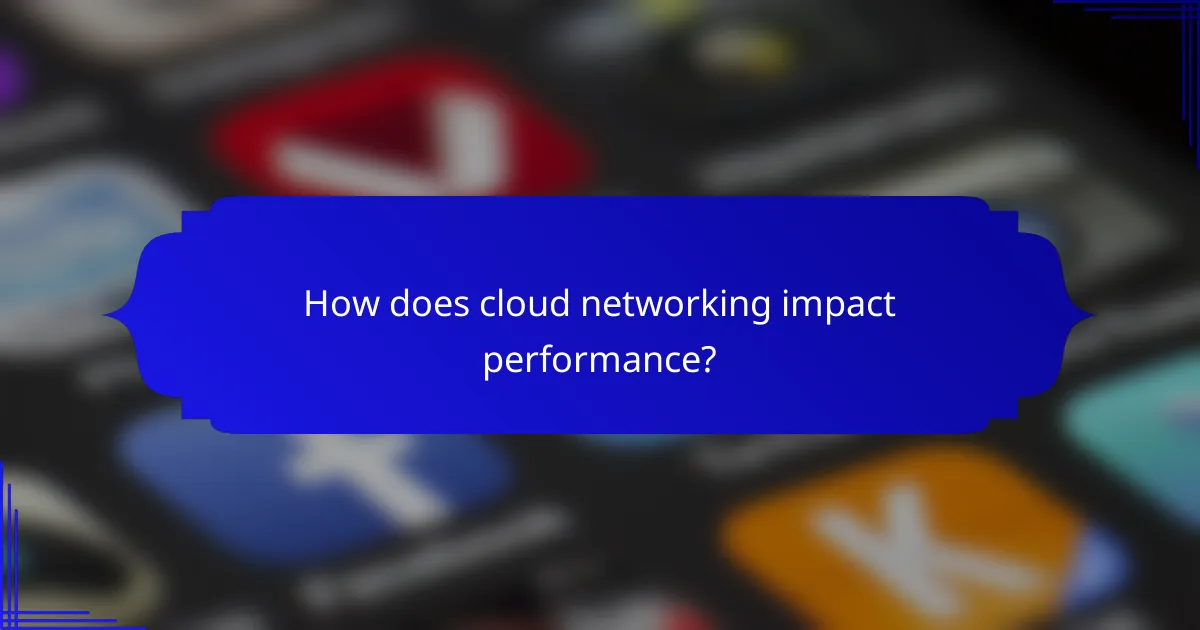
How does cloud networking impact performance?
Cloud networking significantly influences performance by affecting latency, bandwidth, and reliability. Understanding these factors helps organizations optimize their cloud infrastructure for better efficiency and user experience.
Latency considerations
Latency refers to the time it takes for data to travel from the source to the destination. In cloud networking, high latency can lead to delays in application response times, impacting user satisfaction. Aim for latency in the low tens of milliseconds for optimal performance.
Factors influencing latency include the physical distance between users and data centers, network congestion, and the quality of the network infrastructure. Using content delivery networks (CDNs) can help reduce latency by caching data closer to users.
Bandwidth requirements
Bandwidth is the maximum rate of data transfer across a network. Adequate bandwidth is crucial for cloud applications, especially those involving large data transfers or real-time communication. Organizations should assess their bandwidth needs based on user demand and application requirements.
For example, video conferencing applications may require bandwidth in the range of 1-3 Mbps per user, while large file transfers might need significantly higher rates. Regularly monitoring bandwidth usage can help identify potential bottlenecks and inform necessary upgrades.
Service Level Agreements (SLAs)
Service Level Agreements (SLAs) define the expected performance and reliability metrics between cloud service providers and customers. SLAs typically include guarantees for uptime, latency, and support response times, which are critical for maintaining performance standards.
When selecting a cloud provider, carefully review their SLAs to ensure they align with your performance expectations. Look for providers that offer clear penalties for failing to meet SLA commitments, as this can provide additional assurance of their reliability.
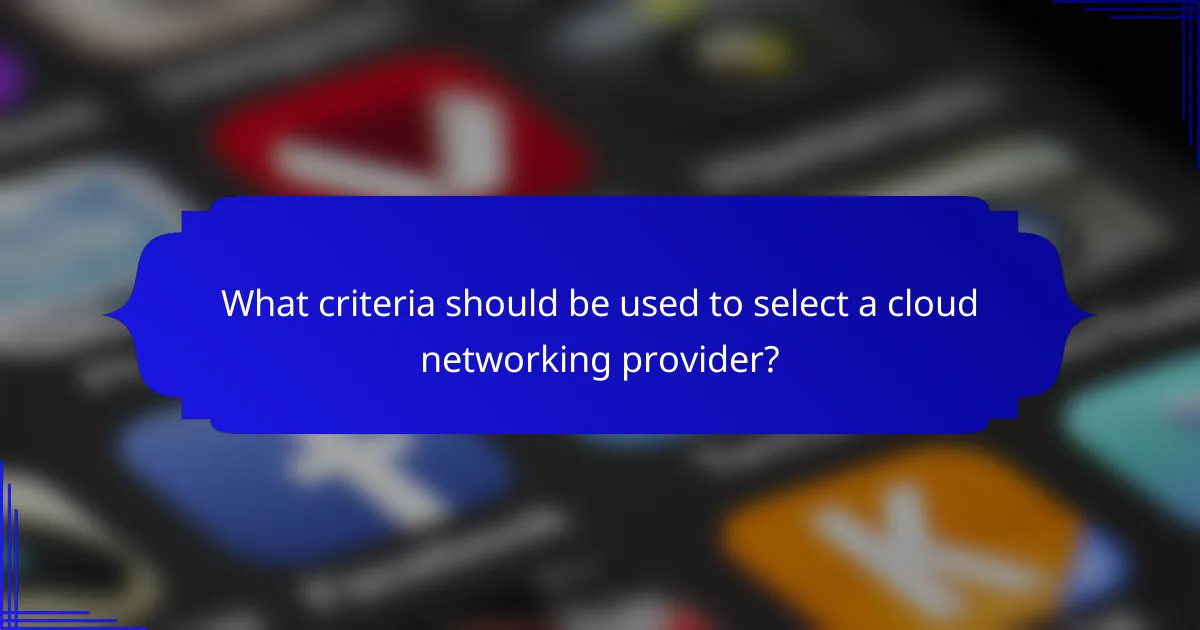
What criteria should be used to select a cloud networking provider?
Selecting a cloud networking provider involves evaluating several key criteria, including reputation, security features, and cost-effectiveness. These factors help ensure that the provider meets your organization’s needs while minimizing risks associated with vendor lock-in and data privacy.
Reputation and reliability
When choosing a cloud networking provider, consider their reputation in the industry and their track record for reliability. Look for providers with positive reviews, strong customer testimonials, and a history of uptime performance that meets or exceeds 99.9%.
Research any past incidents related to service outages or data breaches. A provider with a transparent history and proactive communication during issues is more likely to be trustworthy.
Security features
Security is a critical aspect of cloud networking. Ensure the provider offers robust security features such as end-to-end encryption, multi-factor authentication, and compliance with standards like GDPR or HIPAA, depending on your industry.
Evaluate their data privacy policies and how they handle data breaches. A provider should clearly outline their incident response plan and how they protect sensitive information.
Cost-effectiveness
Cost-effectiveness involves assessing not just the price but the overall value provided by the cloud networking service. Compare pricing models, including pay-as-you-go versus subscription plans, to find what fits your budget best.
Consider hidden costs such as data transfer fees or charges for additional features. A provider that offers a clear pricing structure and transparent billing practices can help avoid unexpected expenses.
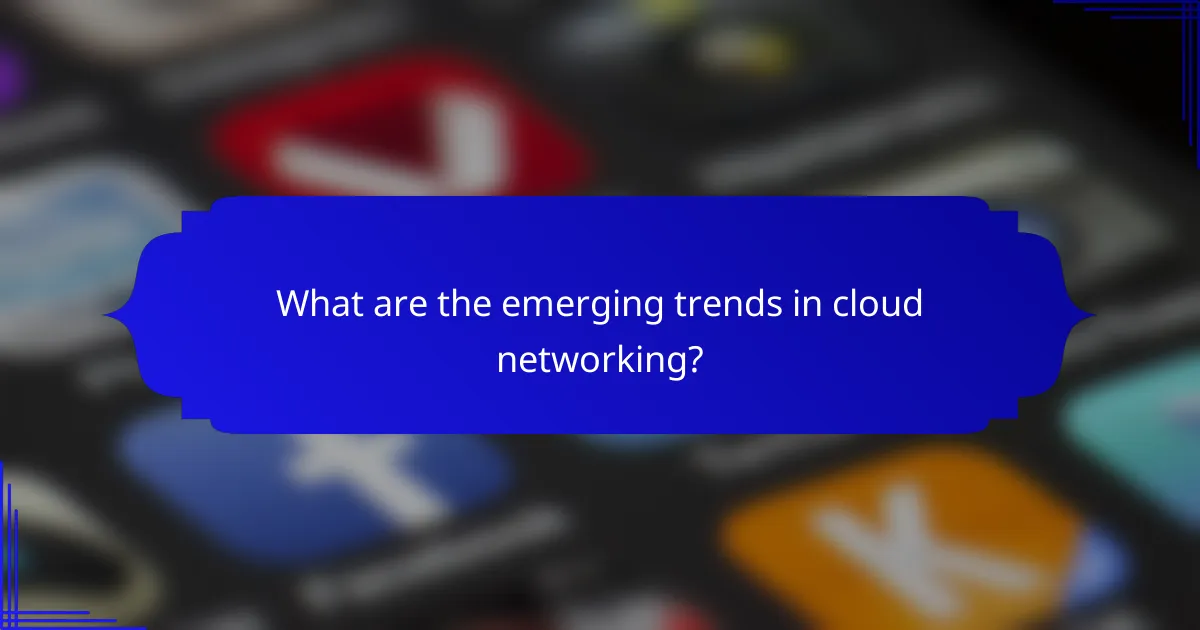
What are the emerging trends in cloud networking?
Emerging trends in cloud networking focus on enhancing efficiency, security, and sustainability. Key developments include the integration of edge computing, AI-driven network management, and a growing emphasis on sustainable practices.
Edge computing integration
Edge computing integration allows data processing to occur closer to the source, reducing latency and improving performance. This trend is particularly beneficial for applications requiring real-time data analysis, such as IoT devices and autonomous vehicles.
Organizations should consider deploying edge computing solutions to optimize bandwidth usage and enhance user experiences. For instance, a retail chain might use edge computing to process transactions and inventory data locally, resulting in faster service and reduced cloud costs.
AI-driven network management
AI-driven network management employs machine learning algorithms to automate and optimize network operations. This technology can predict network issues, enhance security protocols, and streamline resource allocation, leading to improved performance and reduced downtime.
Businesses can leverage AI tools to monitor network traffic patterns and identify anomalies in real-time. For example, a financial institution could use AI to detect unusual transaction behaviors, thereby enhancing security and compliance with regulations.
Increased focus on sustainability
There is a growing emphasis on sustainability in cloud networking, driven by both regulatory pressures and consumer demand for environmentally friendly practices. Companies are adopting energy-efficient technologies and seeking to reduce their carbon footprints through optimized resource management.
Organizations can implement strategies such as using renewable energy sources for data centers and optimizing cooling systems to minimize energy consumption. For example, a tech company might invest in green data centers that utilize solar power, aligning with sustainability goals while potentially reducing operational costs.
